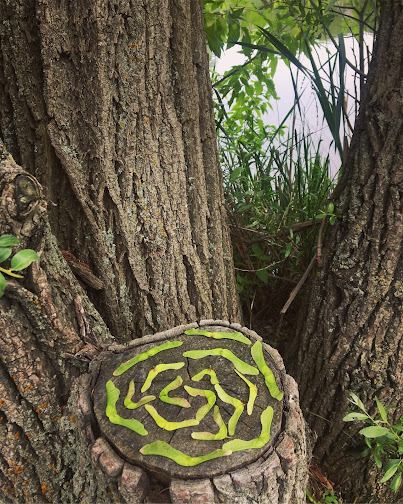2022 Writer-in-Residence at the University of Toronto Scarborough
When I was a kid, I asked my dad to break open a mango seed so that I could see what was inside. First, we washed off the coating of pulp we couldn’t manage to eat, and then we dried the seed until only its wiry fibres remained.
Dad tried everything. Knives varying in size and sharpness, a screwdriver with a red handle, and even the hammer that was too heavy for me to hold.
Finally, after hours of struggle, he cracked it open.
There was nothing inside.
I was convinced that something had rattled when I shook the hairy seed before we broke it— like the jacaranda pod in my grandmother’s garden that jangled with feathery seeds when I tossed it about.
Throughout my childhood, I developed a habit of gathering maple wing nuts in the park, peeling them back to reveal rubbery green seeds. I’d unwrap the paper bark of twigs to reveal the spongy softwood within. Then I’d take them apart, to see what was inside.
I kept looking inside for the thing that compels something to grow. I hadn’t internalized that growth is a collaboration with outside elements.
Some seeds require fire to sprout, like eucalyptus trees. Others, like ash or dandelion, are carried by the wind to their destination. Then there are the seeds that prefer to germinate in the dark, like calendula.
When I started teaching over 10 years ago, I learned quickly and sometimes painfully that students required different approaches to support their creative growth. I’d come into a classroom with an idea that I thought was a surefire winner, but the kids were not having it. Suddenly I had to adapt to what was needed in that moment, and it wasn’t the same for each student.
Some students had so many ideas that they didn’t know where to begin. Others were frozen just by the thought of facing a blank page. And then there were the students who were convinced they weren’t creative at all. Writing, as most of us writers know, roots itself beyond the page. Our perception of ourselves can be as sticky as sap and just as challenging to free ourselves from. Sometimes there are tangles of self-limiting thoughts that are persistent as bindweed, and require consistent uprooting.
Over the years, my students and workshop participants have taught me what kind of outside collaboration they need in order to grow in their creative practice.
Some require steady rain. Others need a strong breeze to propel them in the right direction. And then there are those who need to be firmly placed in the soil.
Like seeds as they grow, students’ needs can vary, shift and adapt over time. If I don’t have enough time with them, I’m denied the joy of supporting and witnessing their growth. That’s why it was such a gift to have had the opportunity to be the Writer-in-Residence at University of Toronto Scarborough. Over three months (still short, I know), I worked with the same students over and over again through writing workshops, one-on-one consultations, and deep dive edits. We prepared the ground, tilled the soil, planted creative seeds, provided sunlight and water (and sometimes fertilizer), and then watched stories and poems bloom. It was poignant, and if I may be so bold, auspicious, to complete my residency at the cusp of spring, when the ground was waking up into blossoms.
I kept reminding my students and myself that while the end result is important and can provide its own sustenance, the magic of transformation occurs in the process. The process is where we uncover what we need to cut back and what needs to take root, deeper into the ground of our lived experience.
There’s a quote that is attributed to a number of authors but no one can arrive at a consensus on who actually wrote it—
Be who you needed when you were younger.
Every time I sit with a student, I face that little kid in me who kept searching for what makes a seed grow, only to realize now that I have the potential to be that thing. Water, sunlight, wind, fertilizer, soil, fire. I can’t be all of them, but if I’m lucky, I can be one of them for a writer with a handful of seeds.
Sheniz Janmohamed was born and raised in Tkaronto with ancestral ties to Kenya and India. A poet, nature artist and arts educator, she regularly visits schools and community organizations to teach and perform. Her nature art has been featured across Turtle Island, including the National Arts Centre and the Art Gallery of Mississauga. She has performed her work in venues across the world and has three poetry collections Bleeding Light (2010), Firesmoke (2014) and Reminders on the Path (2021).
A recipient of the Lois Birkenshaw-Fleming Creative Teaching Scholarship, Sheniz holds an Artist Educator Mentor certificate from the Royal Conservatory. She is a firm believer in fostering community through collaboration and creativity. She recently served as the Writer-in-Residence at the University of Toronto Scarborough Campus (Winter/Spring 2022). She is the founder and facilitator of Owning our Stories, the first writing circle of its kind for South Asian women in Ontario.



